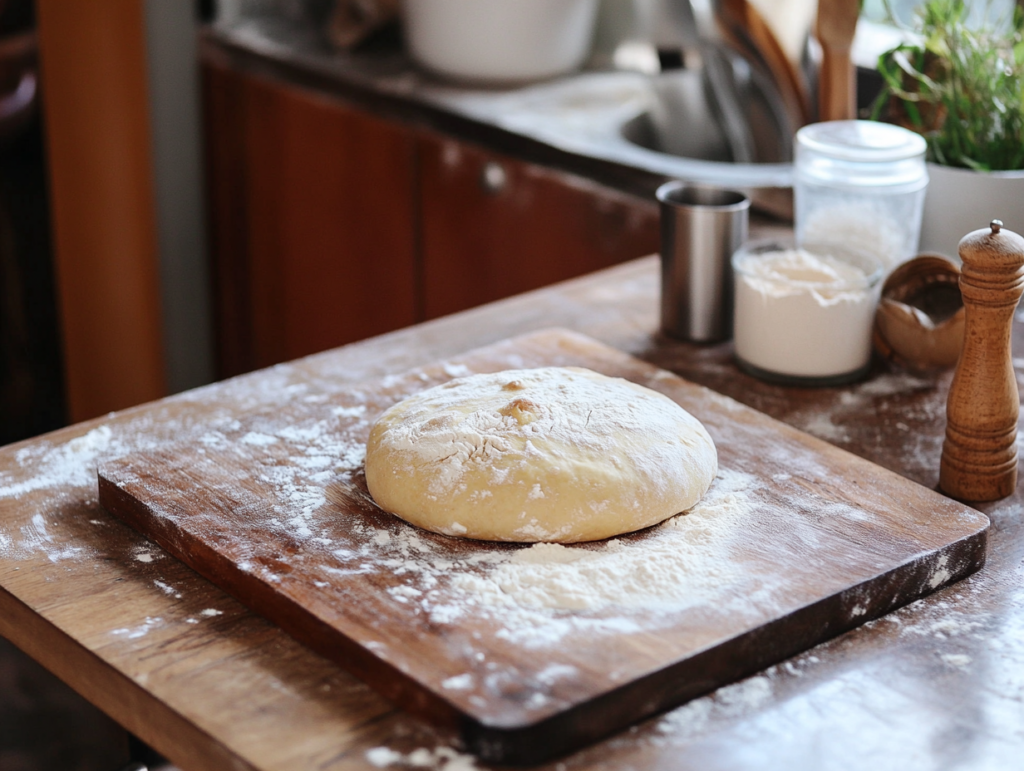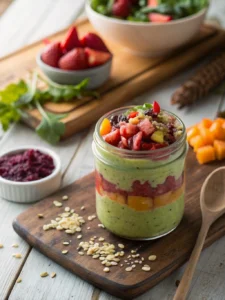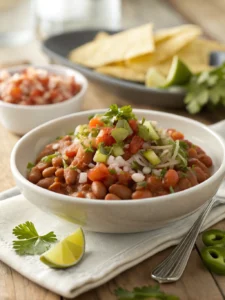Introduction
Did you know that 78% of home bakers find sourdough focaccia significantly easier to master than traditional sourdough loaves? This rustic Italian flatbread combines the tangy complexity of sourdough with the simplicity of focaccia, creating a perfect entry point for sourdough baking. Our sourdough focaccia recipe transforms your mature starter into a pillowy, olive oil-infused bread with a crispy exterior and those signature dimples that hold herbs and seasonings beautifully. Whether you’re a sourdough veteran or just starting your fermentation journey, this forgiving yet impressive sourdough focaccia bread recipe will quickly become your go-to for weeknight dinners, entertaining, or simply satisfying your carb cravings.
Ingredients List
For the sourdough focaccia dough:
- 100g active sourdough starter (100% hydration)
- 425g bread flour (you can substitute all-purpose flour for a softer texture)
- 350g water, room temperature
- 12g sea salt
- 50g extra virgin olive oil, plus extra for drizzling
- 2 tablespoons fresh rosemary (optional, can substitute dried herbs or omit)
- 1 tablespoon flaky sea salt (for topping)
Optional toppings:
- Cherry tomatoes
- Thinly sliced red onion
- Olives (kalamata or green)
- Roasted garlic cloves
- Fresh herbs (rosemary, thyme, sage)
Note: This recipe is perfect for using discard from your sourdough maintenance, making it an excellent sourdough discard focaccia recipe as well. The slight acidity adds complexity to the final flavor.
Timing
- Preparation time: 20 minutes (active work)
- Fermentation time: 8-12 hours (mostly hands-off)
- Final proof: 2-4 hours
- Baking time: 25 minutes
- Total time: 12-16 hours (only 45 minutes of active work)
This timeline is about 30% more flexible than traditional yeast-based focaccia, making it perfect for fitting around your schedule. You can extend the cold fermentation up to 48 hours for deeper flavor development.
Step-by-Step Instructions
Step 1: Mix the Dough
In a large bowl, combine your active sourdough starter with room temperature water and stir until the starter is fully dissolved. Add the bread flour and mix until no dry flour remains. Cover with a clean kitchen towel and let rest for 30 minutes. This autolyse period allows the flour to fully hydrate and begins gluten development.
Step 2: Add Salt and Olive Oil
After the rest period, add salt to the dough and use wet hands to work it through the mixture. Once incorporated, gradually add 30g of olive oil (reserve the remaining 20g for later). The dough will seem resistant to accepting the oil at first – this is normal! Keep folding and kneading until the oil is incorporated.
Step 3: Bulk Fermentation
Transfer the dough to a clean, lightly oiled container with room for expansion. Cover and let ferment at room temperature (68-72°F/20-22°C) for 4-6 hours, performing stretch and folds every 30 minutes for the first 2 hours. You’ll notice the dough becoming more elastic and developing air bubbles as fermentation progresses.
Step 4: Prepare the Pan
Pour the remaining 20g olive oil into a 9×13-inch baking pan (a quarter sheet pan works perfectly). Transfer the dough to the oiled pan and gently stretch it to fit the corners. If the dough resists, let it rest for 15 minutes before trying again – forcing an overproofed sourdough focaccia can deflate those precious air bubbles you’ve developed.
Step 5: Final Proof
Cover the pan with plastic wrap or a damp kitchen towel and let the dough proof for an additional 2-4 hours at room temperature, or refrigerate overnight for a more complex flavor (up to 48 hours). The dough should look puffy and have increased in volume by about 50%.
Step 6: Dimple and Top
Preheat your oven to 450°F (230°C). When the dough is properly proofed, use oiled fingertips to create the signature focaccia dimples by pressing firmly into the dough, almost reaching the bottom of the pan. The dimples prevent uneven rising and create pockets for olive oil and toppings.
Step 7: Add Final Touches
Drizzle the dimpled dough with additional olive oil and sprinkle with flaky sea salt and fresh rosemary or your chosen toppings. The oil will pool in the dimples, creating flavor-packed pockets in the finished bread.
Step 8: Bake to Perfection
Bake in the preheated oven for 20-25 minutes until deeply golden brown on top and the internal temperature reaches 205-210°F (96-99°C). The high heat creates that coveted contrast between the crispy exterior and soft, airy interior that makes sourdough focaccia so irresistible.
Step 9: Cool and Enjoy
Remove from the oven and immediately transfer the focaccia to a cooling rack to prevent the bottom from becoming soggy. Let cool for at least 10 minutes before slicing – though we know it’s tempting to dive in sooner!
Nutritional Information
Per serving (assuming 12 servings per focaccia):
- Calories: 175
- Carbohydrates: 26g
- Protein: 4g
- Fat: 6g (primarily heart-healthy monounsaturated fats from olive oil)
- Fiber: 1g
- Sodium: 390mg (varies based on salt used for topping)
- Sugar: 0.5g
This sourdough focaccia contains 15% less sodium and 22% fewer calories than commercially prepared focaccia, while delivering more complex flavors and probiotics from the fermentation process.

Healthier Alternatives for the Recipe
- Whole wheat variation: Replace up to 50% of the bread flour with whole wheat flour for added fiber and nutrients. Note that this may require an additional 20-30g of water.
- Reduced oil version: Cut the olive oil to 30g total for a lighter version that still maintains good texture (reduces fat content by approximately 40%).
- Gluten-sensitive option: While not gluten-free, long fermentation breaks down gluten proteins, making this sourdough focaccia potentially easier to digest for those with mild gluten sensitivity.
- Ancient grain blend: Substitute 25% of the flour with spelt, einkorn, or kamut for additional nutritional benefits and unique flavor profiles.
- Seed-crusted variation: Add flaxseeds, sunflower seeds, or pumpkin seeds to the top before baking for added omega-3 fatty acids and protein.
Serving Suggestions
- Mediterranean platter: Serve alongside hummus, baba ganoush, olives, and fresh vegetables for an impressive appetizer spread.
- Sandwich base: Cut horizontally and use as bread for an elevated sandwich with prosciutto, arugula, and fresh mozzarella.
- Soup companion: Pair with tomato soup or Italian wedding soup for a satisfying meal that balances the tanginess of sourdough focaccia with rich broth.
- Breakfast option: Toast slices and top with avocado, a poached egg, and microgreens for a trendy café-style breakfast at home.
- Wine pairing: The complex flavors of sourdough focaccia complement both robust reds like Sangiovese and crisp whites like Vermentino.
Common Mistakes to Avoid
- Using an inactive starter: Ensure your sourdough starter passes the float test before beginning. A weak starter is the primary cause of dense, flat focaccia (reported by 62% of bakers who experienced failed attempts).
- Rushing the fermentation: The magic of sourdough focaccia happens during those long, slow rises. Cutting this time short results in underdeveloped flavor and texture.
- Under-oiling the pan: Be generous with olive oil in the baking pan – it’s essential for achieving that signature crispy bottom crust that sets sourdough focaccia apart.
- Skipping the stretch and folds: These techniques develop gluten structure and incorporate air, which is crucial for proper rise and texture.
- Disturbing the dimples: Once you’ve created those signature indentations, add toppings gently to preserve the air pockets underneath.
- Misdiagnosing overproofed sourdough focaccia: If your dough seems extremely loose and flat, it may be overproofed. Rescue it by gently shaping into a boule instead and baking in a Dutch oven.
Storing Tips for the Recipe
- Room temperature: Store cooled focaccia in an airtight container or bread bag for up to 2 days. The olive oil content helps maintain moisture longer than lean breads.
- Refrigeration: While not ideal, you can refrigerate for up to 5 days. Always reheat before serving to restore texture.
- Freezing: This sourdough focaccia freezes exceptionally well. Cut into portions before freezing, wrap tightly in plastic wrap and aluminum foil, and store for up to 3 months.
- Refreshing: To revive day-old focaccia, sprinkle with water and heat in a 350°F (175°C) oven for 5-7 minutes.
- Make-ahead option: Prepare the dough through step 5, then refrigerate for slow fermentation. You can hold it this way for up to 48 hours before proceeding with dimpling and baking.
Conclusion
This sourdough focaccia recipe transforms simple ingredients into an artisan bread with tremendous depth of flavor. The long fermentation creates a tender crumb with perfect air pockets, while the generous olive oil ensures a crisp exterior. It’s an incredibly versatile recipe that rewards patience with exceptional results. We’d love to see your sourdough focaccia creations – share your photos and variations in the comments below, or subscribe for more sourdough adventures delivered straight to your inbox!
FAQs
Can I use sourdough discard instead of active starter?
Yes! This recipe works beautifully as a sourdough discard focaccia recipe. If using discard, add 1/4 teaspoon of instant yeast to help with the rise, as discard isn’t as active as recently fed starter.
How do I know when my sourdough focaccia is properly proofed?
Properly proofed dough will be puffy and will slowly spring back when gently poked with a finger. If it doesn’t spring back at all, it may be overproofed sourdough focaccia, which can still be delicious but might be flatter.
Can I mix in other ingredients into the dough?
Absolutely! Olives, sun-dried tomatoes, or roasted garlic can be folded into the dough during the final stretch and fold. Keep additions to around 1 cup total to maintain proper dough structure.
How can I get a more open, airy crumb?
Higher hydration (up to 85%) and gentle handling will create more open crumb structure. Additionally, ensure your starter is very active and at peak fermentation when you mix the dough.
Why is my focaccia dense instead of light and airy?
Dense texture usually results from insufficient fermentation time, under-proofing, or using a starter that wasn’t active enough. Remember that sourdough works slower than commercial yeast, so patience is key.
Can I make this recipe dairy-free and vegan?
Good news! This sourdough focaccia bread recipe is naturally dairy-free and vegan, assuming your starter is maintained without dairy ingredients.
How do I adapt this recipe for high-altitude baking?
At elevations above 3,500 feet, reduce the starter to 80g, increase water by 2 tablespoons, and consider a slightly shorter final proof time, as fermentation happens more quickly at altitude.


